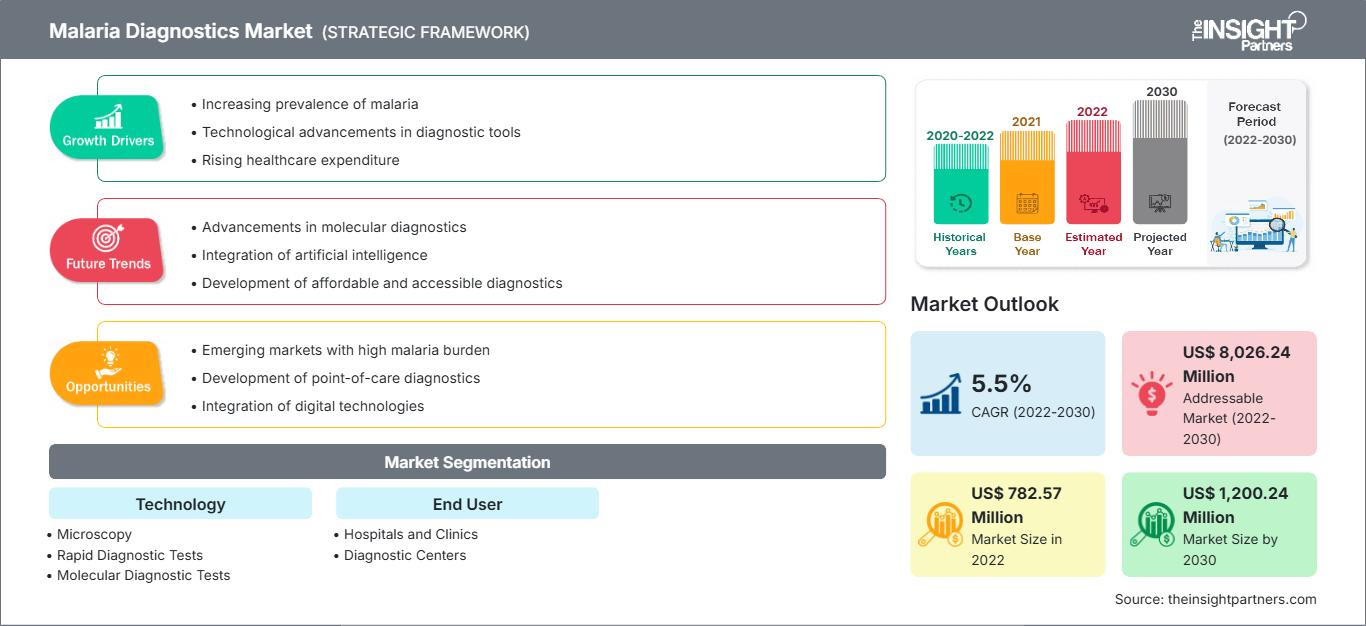[Research Report] The malaria diagnostics market size is projected to grow from US$ 782.57 million in 2022 to US$ 1,200.24 million by 2030; the market is estimated to record a CAGR of 5.5% during 2022–2030.
Market Insights and Analyst View:
Malaria is a life-threatening disease caused by the Plasmodium parasite. The malaria diagnostics market is growing due to the high incidence of malaria in low-income countries and globally implemented malaria elimination programs by international and national organizations. The increasing launches of advanced diagnostic tools and rising research activities for effective therapeutics are further contributing to the growth of the market.
Before the COVID-19 pandemic, almost one-third of endemic nations were progressing toward international goals. Many low-incidence nations were part of the WHO's "Elimination 2025 Initiative," which is represented by a group of 25 nations striving to potentially eliminate malaria by 2025. On the other hand, progress reached a standstill in about one-third of the countries, while in the other countries, the incidence of malaria rose. Countries with larger disease burdens are showing more inclination toward using diagnostic test data to stratify and focus geographically suitable interventions, irrespective of the continued importance of testing and screening in eradication attempts.
Malaria cases and deaths were on the rise in the first year of the COVID-19 epidemic due to minor disruptions in case management and preventative efforts. Nonetheless, a possible worst-case scenario—the doubling of malaria deaths—was avoided with the cooperative efforts of the WHO, National Malaria Programs, and partners. Difficulties in obtaining necessary malaria supplies and the uncertain pattern of how the pandemic ultimately affected malaria management measures.
Growth Drivers:
Malaria, one of the acute febrile illnesses, is caused by plasmodium parasites and spreads through the infected female Anopheles mosquitoes. Five parasite species in humans mainly cause malaria, and two of these species—Plasmodium falciparum and P. vivax—are considered the greatest threat. Also, P. falciparum is the deadliest malarial parasite, and it is most widely spread across the African continent. Further, P. vivax is the dominant malarial parasite in most countries outside of sub-Saharan Africa. According to the World Malaria Report (WMR) 2020 from the World Health Organization (WHO), 241 million malaria cases were reported worldwide, compared to 227 million cases logged in 2019. According to the same source, the number of deaths caused by malaria increases by 69,000 annually. Approximately two-thirds of these deaths, i.e., 47,000, were caused by disruptions in healthcare services during the COVID-19 pandemic; the remaining one-third of deaths, i.e., 22,000 reflected a recent change in the WHO’s methodology for calculating malaria mortality (irrespective of COVID-19 disruptions).
In 2020, ~95% of global cases and ~96% of deaths caused by malaria were reported in the WHO African region, and ~80% of the total deaths that were reported were in children aged 5 and below. According to WMR 2021, ∼2% of the global burden of malaria was recorded in Southeast Asian countries, wherein India accounted for 83% of estimated malaria cases and 82% of deaths associated with the disease in 2020. Thus, the rising prevalence of malaria in different regions globally boosts the growth of the malaria diagnostics market.
A limited number of WHO-prequalified products that are non-Pf mRDTs are available in the market. Despite the availability of a broad range of WHO-prequalified mRDT products, the demand is concentrated around a preferred subset of specific products and manufacturers. This limits the market’s ability to ensure supply diversity, security, and production capacity. In line with this, manufacturers face challenges such as low product demand from some countries as well as their reluctance and lack of interest in adopting alternative products. The adoption of alternative brands be triggered by changing brands selected for the national algorithms or by cost implications.
Customize This Report To Suit Your Requirement
You will get customization on any report - free of charge - including parts of this report, or country-level analysis, Excel Data pack, as well as avail great offers and discounts for start-ups & universities
Malaria Diagnostics Market: Strategic Insights

- Get Top Key Market Trends of this report.This FREE sample will include data analysis, ranging from market trends to estimates and forecasts.
You will get customization on any report - free of charge - including parts of this report, or country-level analysis, Excel Data pack, as well as avail great offers and discounts for start-ups & universities
Malaria Diagnostics Market: Strategic Insights

- Get Top Key Market Trends of this report.This FREE sample will include data analysis, ranging from market trends to estimates and forecasts.
Report Segmentation and Scope:
The “malaria diagnostics market” is segmented on the basis of technology and end user. The malaria diagnostics market, by technology, is segmented into microscopy, rapid diagnostic tests (RDTs), and molecular diagnostic tests. The rapid diagnostic tests (RDTs) segment held the largest market share in 2022 and is estimated to register the highest CAGR in the market during 2022–2030. The malaria diagnostics market, by end user, is divided into hospitals and clinics, diagnostic centers, and others. The hospitals and clinics segment held the largest market share in 2022. The diagnostic centers segment is expected to register the highest CAGR in the market during 2022–2030.
Segmental Analysis:
The malaria diagnostics market, by technology, is segmented into microscopy, rapid diagnostic tests (RDTs), and molecular diagnostic tests.
The rapid diagnostic tests (RDTs) segment held the largest share of the market in 2022 and is projected to register the highest CAGR in the market during 2022–2030. By demonstrating the presence of malaria parasites in human blood, malaria rapid diagnostic tests (RDTs) aid in the diagnosis of malaria. RDTs offer an alternative to clinically based diagnosis or microscopy, especially in situations when access to high-quality microscopy services is limited. Plasmodium falciparum or P. vivax is the only species that certain RDTs can identify, but others can identify four species: P. falciparum, P. vivax, P. malariae, and P. ovale. Usually, a finger prick is used to draw blood for the test.
The malaria diagnostics market, by end user, is segmented into hospitals and clinics, diagnostic centers, and others. Hospitals and clinics are notably evolving with the rising number of patients worldwide. They deliver highly effective treatments in low-cost settings. the growing emphasis on the usage of RDTs for their rapid turnaround times, low costs, and convenient accessibility is one of the main causes of the dominance of clinics in the malaria diagnostics market.
Regional Analysis:
The global malaria diagnostics market is geographically segmented into North America, Europe, Asia Pacific, South & Central America, and the Middle East & Africa. Due to growing investments by developed nations such as the US and the US, larger patient populations, and an increasing emphasis by the World Health Organization (WHO) on lowering the malaria death rate in African countries, the Middle East and Africa region is anticipated to maintain its market dominance over the forecast period. Based on data released by the WHO in July 2022, it is probable that Sub-Saharan Africa accounts for roughly 95% of the disease cases and 96% of deaths.
Malaria Diagnostics Market Regional Insights
The regional trends and factors influencing the Malaria Diagnostics Market throughout the forecast period have been thoroughly explained by the analysts at The Insight Partners. This section also discusses Malaria Diagnostics Market segments and geography across North America, Europe, Asia Pacific, Middle East and Africa, and South and Central America.
Malaria Diagnostics Market Report Scope
| Report Attribute | Details |
|---|---|
| Market size in 2022 | US$ 782.57 Million |
| Market Size by 2030 | US$ 1,200.24 Million |
| Global CAGR (2022 - 2030) | 5.5% |
| Historical Data | 2020-2022 |
| Forecast period | 2022-2030 |
| Segments Covered |
By Technology
|
| Regions and Countries Covered | North America
|
| Market leaders and key company profiles |
|
Malaria Diagnostics Market Players Density: Understanding Its Impact on Business Dynamics
The Malaria Diagnostics Market is growing rapidly, driven by increasing end-user demand due to factors such as evolving consumer preferences, technological advancements, and greater awareness of the product's benefits. As demand rises, businesses are expanding their offerings, innovating to meet consumer needs, and capitalizing on emerging trends, which further fuels market growth.

- Get the Malaria Diagnostics Market top key players overview
Industry Developments and Future Opportunities:
Various strategic developments by leading players operating in the malaria diagnostics market are listed below:
- In February 2022, the Kenya Medical Research Institute (KEMRI) launched Plasmochek for Malaria testing. Plasmochek is designed to detect plasmodium, a parasite responsible for causing malaria. The kit utilizes antibodies specific to Plasmodium falciparum histidine-rich protein II and Plasmodium lactate dehydrogenase to detect malaria infections.
- In Dec 2019, Access Bio and Global Good (a collaboration partner of the former) developed a new ultra-sensitive rapid diagnostic test (uRDT) that is five times more sensitive in identifying histidine-rich protein 2 (HRP2) antigens than currently available uRDTs. Additionally, a variety of tools have been created to improve malaria diagnosis.
Competitive Landscape and Key Companies:
Access Bio., Inc.; Abbott Laboratories; Premier Medical Corporation Pvt. Ltd.; Sysmex Partec GmbH; bioMerieux; Beckman Coulter Inc.; Siemens Healthineers; Leica Microsystems GmbH; Nikon Corporation; Olympus Corporation; and Bio-Rad Laboratories Inc. are the prominent companies in the malaria diagnostics market. These companies focus on new technologies, upgrading existing products, and geographic expansions to meet the growing consumer demand worldwide.
Frequently Asked Questions
Which region is the fastest growing the malaria diagnostics market?
Which end user segment is dominating the malaria diagnostics market?
Which technology segment is dominating the malaria diagnostics market?
Which country is dominated the malaria diagnostics market?
What are the driving factors for the malaria diagnostics market across the globe?
What is malaria diagnostics?
Who are the major players in the malaria diagnostics market?
- Historical Analysis (2 Years), Base Year, Forecast (7 Years) with CAGR
- PEST and SWOT Analysis
- Market Size Value / Volume - Global, Regional, Country
- Industry and Competitive Landscape
- Excel Dataset
Recent Reports
Testimonials
Reason to Buy
- Informed Decision-Making
- Understanding Market Dynamics
- Competitive Analysis
- Identifying Emerging Markets
- Customer Insights
- Market Forecasts
- Risk Mitigation
- Boosting Operational Efficiency
- Strategic Planning
- Investment Justification
- Tracking Industry Innovations
- Aligning with Regulatory Trends





















 Get Free Sample For
Get Free Sample For